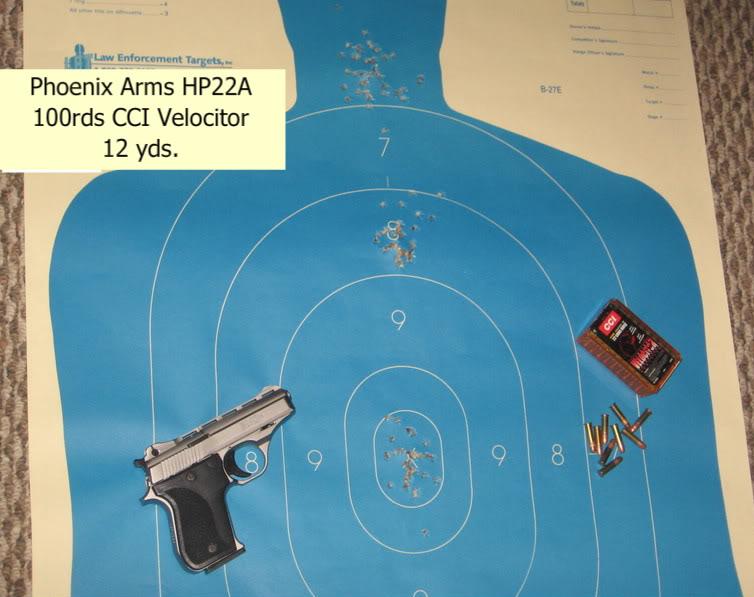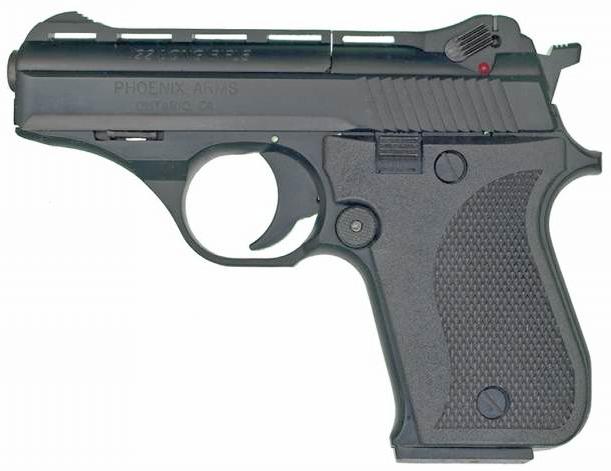
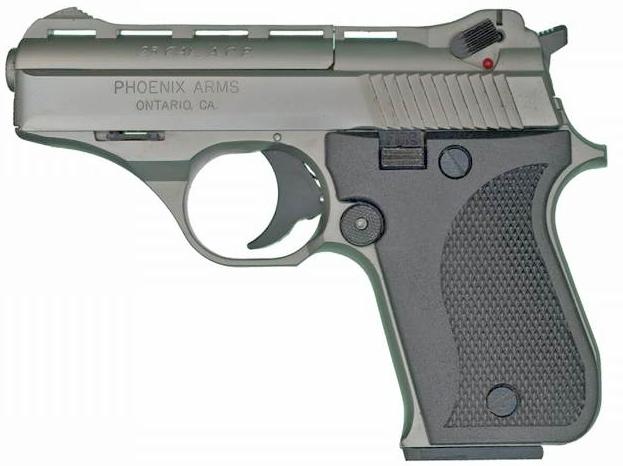

I've always been interested in small guns, and over the years have thought about getting one of these little 22s from Phoenix Arms. I've seen them in pawn shops, and in local gun stores in the Chattanooga area. (This is a link to the Phoenix Arms homepage.) I was visiting Valu Pawn on Highway 153 last week, and saw a "Deluxe Range Kit" there. The Deluxe HP22A kit includes the extra long barrel, as well as the shorter barrel. You can buy the kit, or you can buy the pistol with only the shorter barrel, at a reduced price. The kit was selling for $220, which is much more than the price I saw a year or two ago, but I have seen the Deluxe Kit advertised on Gunbroker.com for $260, so maybe I did OK. Prices have gone up on just about all firearms this past year and a half. So, I happened to have exactly the right amount of gun money with me, and bought the kit. The finish is either "blued" or "nickel." Here's what that looks like in the short barrel version:


From the official website: "Phoenix Arms Model HP22A is a single action semi-auto .22LR caliber pistol with a staggered 10-round magazine that makes for a compact and comfortable fit in the hand. Weighing in at just 20 ounces in a size 4.1 by 5.5 inches, features include 3-inch vented rib barrel, serrated trigger, adjustable rear sight, magazine interlock with a manual slide hold open, external hammer and firing pin block safety. Available in satin nickel or matte black finish. Phoenix Arms Model .22LR Rangekit features our HP22A with a 5-inch vented rib barrel for increased accuracy and an extended grip 10-round stagger box magazine. Weighing in at just over 23-ounces in a size 4.8 by 7.5 inches with all of the features of our standard pistol., this HP22A comes packed in a custom fitted locking transport case that is complete with cleaning kit, gun oil and integrated pistol locking device. Available in satin nickel or matte black finish. Phoenix Arms Model .22LR Deluxe Rangekit gives you the ability to change the configuration of your HP22A pistol to suit your style and situation. Get the compact sport size of our standard model as well as the 5-inch target barrel and extended grip magazine to take it to the next level of target shooting. Comes complete with a custom fitted locking transport case that includes cleaning kit, gun oil, and integrated pistol locking device. Available in satin nickel or matte black finish." There are a number of inexpensive but interesting accessories available (holster, extra mags, etc.).
A LITTLE HISTORY
Phoenix Arms pistols are said to be some of the best selling handguns on the market, but I don't have the actual production figures. Where did the Phoenix Arms company come from? Read on...
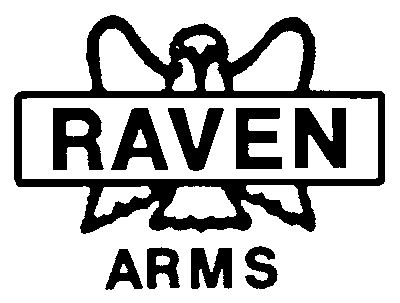 Founded 1970 by George Jennings |
 Phoenix Arms - Ontario California |
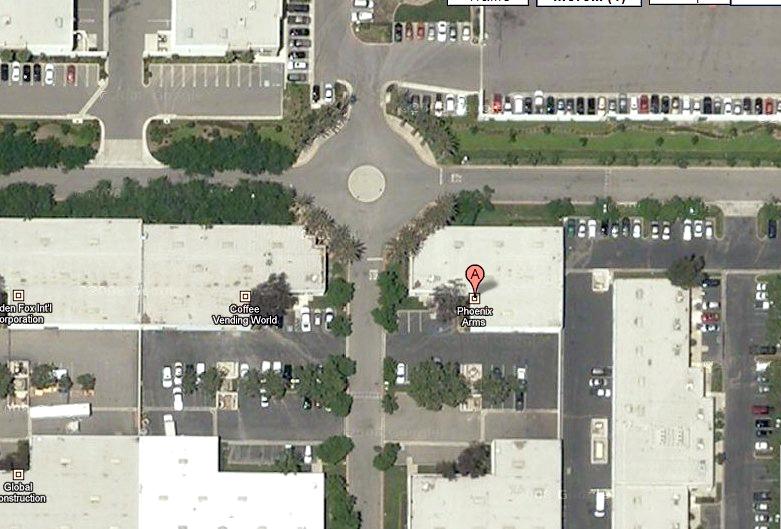
Ring of Fire 'Families' (From WGBH TV -- Frontline)
If it wasn't George Jennings it probably would have been someone else. Capitalizing on a provision in the Gun Control Act of 1968, which banned the importation of cheap, poorly-made handguns, Jennings created his own design for a small caliber, easily-produced pistol.
That design launched a domestic manufacturing empire which churns out high volumes of handguns commonly referred to as "Saturday Night Specials." This extended family of businesses has been dubbed the "Ring of Fire" by critics, and now consists of five southern California companies which in 1993 produced almost 900,000 handguns.
A machinist by trade, George Jennings founded Raven Arms in 1970. His son Bruce Jennings joined Raven two years later, but left in 1978 to start Jennings Firearms. In 1982, George Jennings helped his daughter Gail and her husband Jim Davis, formerly the office manager at Raven Arms, start Davis Industries. Jim's brother John Davis, a machine operator at Raven, also went to work at Davis Industries.
Davis Industries
Bryco ArmsIn 1985, faced with the prospect of losing his Federal Firearms License for a felony assault charge, Bruce Jennings sold Jennings Firearms to Calwestco, owned by a his former office manager, Gene Johnson. After plea bargaining the charge down to a misdemeanor, Bruce Jennings converted Jennings Firearms into a firearms wholesaler and established a new company, Bryco Arms, controlled by his ex-wife Janice, to manufacture firearms. Jennings Firearms, the wholesaler, bought guns from both Calwestco and Bryco Arms, and resold them to distributors. In 1991, Calwestco closed.
In 1987, John Davis left Davis Industries to start his own gun manufacturing business, Sedco Industries Inc. John Davis was in business for only three months before a $45 million dollar lawsuit alleging he stole trade secrets was filed against him by George and Bruce Jennings, and his own brother, Jim Davis. Sedco closed in 1989, and John Davis declared bankruptcy three years later. That same year, a nephew of George Jennings started Sundance Industries.
Sundance Industries
Lorcin EngineeringJim Waldorf, a childhood friend of Bruce Jennings, set up his own gun manufacturing business in 1989, Lorcin Engineering. He brought in John Davis as plant manager and by 1993 Lorcin was making more pistols (341,243) than any gun maker in the U.S.
The original Jennings company, Raven Arms, was destroyed by fire in 1991. But soon after the company re-emerged as Phoenix Arms. Phoenix is equally owned by Bruce Jenning's ex-wife Janice, his three children, Jim Davis' four children, and Raven's former general manager, Dave Brazeau. George Jennings has since died.
A Little More Information About the Ring of Fire Companies
Jimenez Arms--Bryco's former foreman, Paul Jimenez, bought the bankrupt Bryco Arms for $510,000 in August 2004, and renamed the company Jimenez Arms. The former Model 380 (the 380 ACP version of the Model 38) was renamed the JA-380, and production of the same semi-automatic pistol design was resumed. The weapons were re-engineered to improve their safety. The JA-NINE, the former Bryco Arms Model 380 (renamed the JA-380), the former Jennings J-22 (renamed the JA-22 LR), and the Jennings J-25 (renamed the JA-25 Auto) quickly became the only firearms currently manufactured by the company.
The California Attorney General ordered Jimenez Arms to stop producing arms in Costa Mesa, California on August 22, 2006. As a result, the company has moved to Nevada. A business license was granted on August 30, 2006 for Jimenez Arms to commence operation in Henderson, Nevada, and production has resumed there. Jimenez firearms are distributed by Shining Star Investments.
"Ring of Fire" was invented as a derogatory term for so-called "Saturday night special" guns. These terms were coined by anti-gun people, who wish to push strict "gun control" and gun confiscation on the American people. So far, the 2nd Amendment to the Constitution has prevailed, and the gun contollers are not having their way (except in California, and in isolated cities: New York, Chicago, Washington, DC, etc.) It should be noted that in these cities with strict gun control, violent gun related crimes have not been curtailed. "When guns are outlawed, outlaws will still have guns." My personal take is that every American has the right, and even the obligation, to own a firearm. Some people can only afford inexpensive weapons, so I am glad that guns like the Phoenix Arms HP22A are available. It is a rule of history: when governments confiscate firearms, those same governments are about to strip their citizens of their rights and freedoms, and often massacre their own citizens by the millions. It has been demonstrated in many countries. Let's not let it happen here in the USA.
Back to my review!
Whenever I buy a gun, the first thing I do is read the manual. Then I take it apart and clean it, and sometimes I sand down rough spots, or polish the feed ramp. The HP22A definitely NEEDED some polishing up! Here are some photos of the HP22A kit. As you can see, it comes in a very nice plastic box...


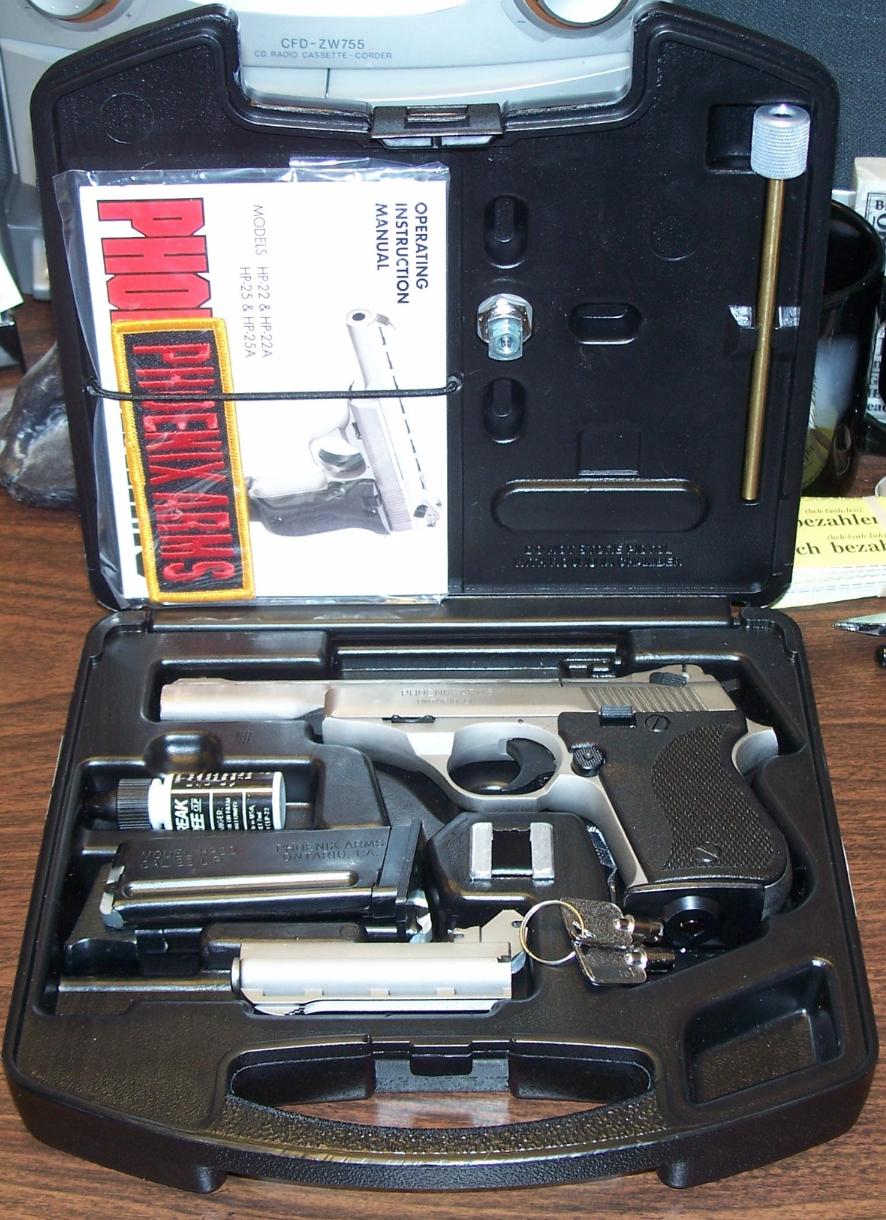
The box contains all kinds of stuff! The pistol, with the long barrel already installed; the short barrel; two magazines, one with a pinky extension; a fancy locking mechanism that fits in the mag well; a cleaning kit with nifty rod, three attachments, and round cotton patches; ear plugs; manual and warranty card (there is a lifetime warranty). There's even a little bottle of Breakfree cleaner/lubricant.

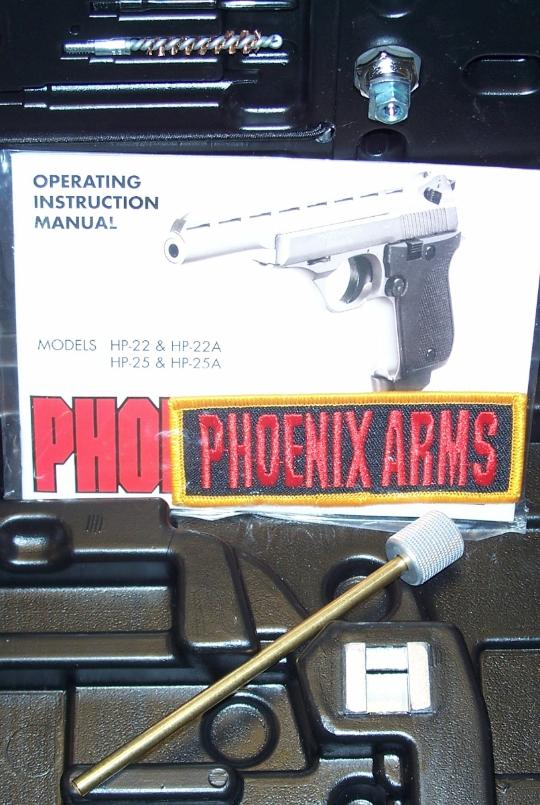
The magazines are of quite sturdy steel construction. The followers are solid metal (not stamped). The pinky extension base is not plastic, but seems to be of solid aluminum. HP22A magazines hold ten rounds. (There are older model mags that hold eleven rounds.)
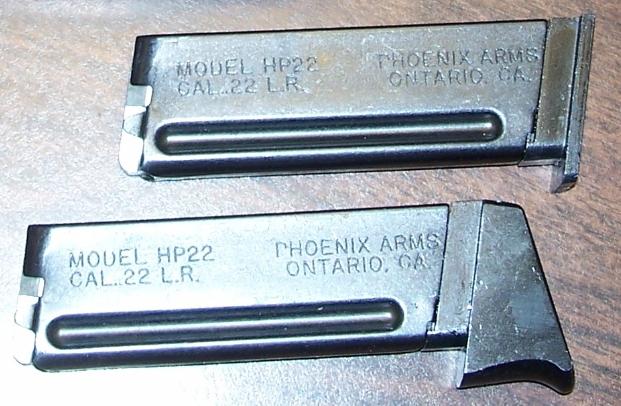


Phoenix Firearms seems to be VERY concerned about safety (or this may have to do with the manufacturing facilities being located in California, home of strict firearms regulations. There are two safeties. The one on the slide, with a red dot under it, which is a firing pin block. There is also a safety at the top of the left grip panel. When in the Fire position, you can not remove the magazine. Press it up to Safe, and the ten-round mag can be pulled out. This safety button can also be used to lock the slide back. With the button in Safe, you can not rack the slide fully, but you can check the chamber and see part of a cartridge. There is also a lock that fits up in the magazine well, for safe storage. Also, the plastic case for storing the weapon comes with an integral lock. (Two keys are supplied in the kit, and the keys fit both the magazine well lock, and the box lock.)
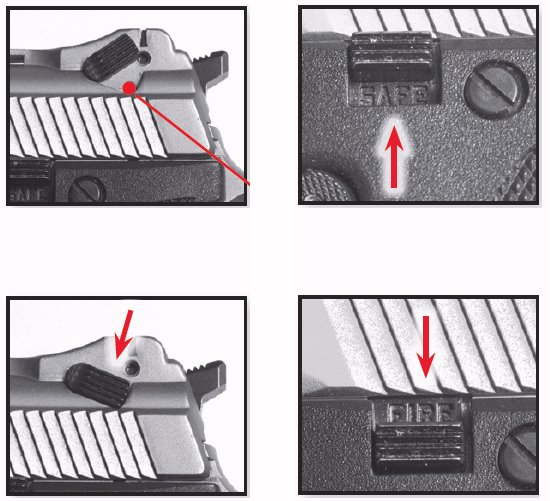
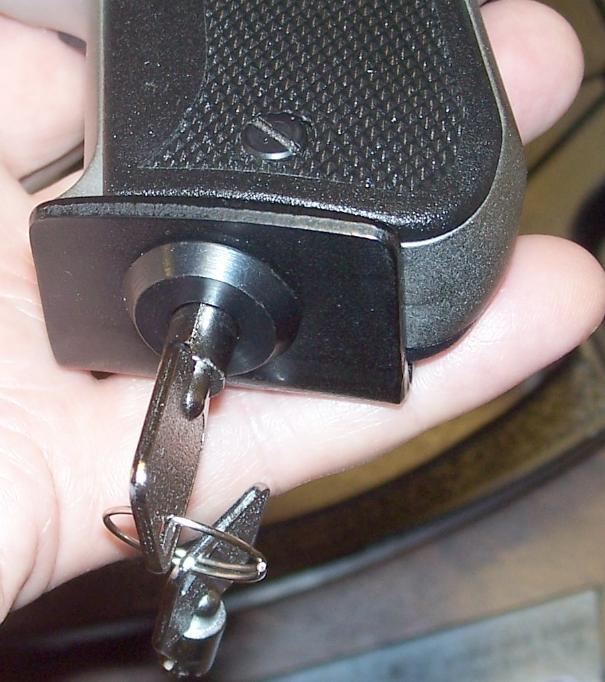

If your Phoenix HP22A jams on you while at the firing range, it is more difficult to clear the jam than it would be on a GLOCK or similar firearm. The interlocking safeties of the HP22A make it impossible to drop your magazine, then rack the slide and clear the chamber. Because of this difficulty in clearing jams, some HP22A owners have learned to de-activate the mechanism which prevents dropping the magazine. "Mark from Iowa" posted how to do this on the Forum.
If you are used to the simplicity of taking apart a GLOCK, and the ease of putting it back together again, you will be challenged by the Phoenix Arms HP22A. However, "it's not brain surgery," and using the manual's instructions and photos, I was able to take the gun apart, and clean and oil it, and re-assemble it (and it didn't take very long, either!)
The frame, slide, and barrel housing of the HP22A are made of non-magnetic zinc castings, with steel inserts at various places, such as the bore, the breech face, and where the slide presses against the hammer to cock it during ejection. Some internal parts are steel. The gun is made of inexpensive materials, and assembled with not too much of an eye toward quality control. Not much (if anything) in the gun is "machined." There was a "tab" of metal hanging on the short barrel, which I cut off with a sharp bladed screw driver. There are lots of raised casting seams, that I will eventually file off. The metal is quite soft, and can be filed, cut and sanded easily.
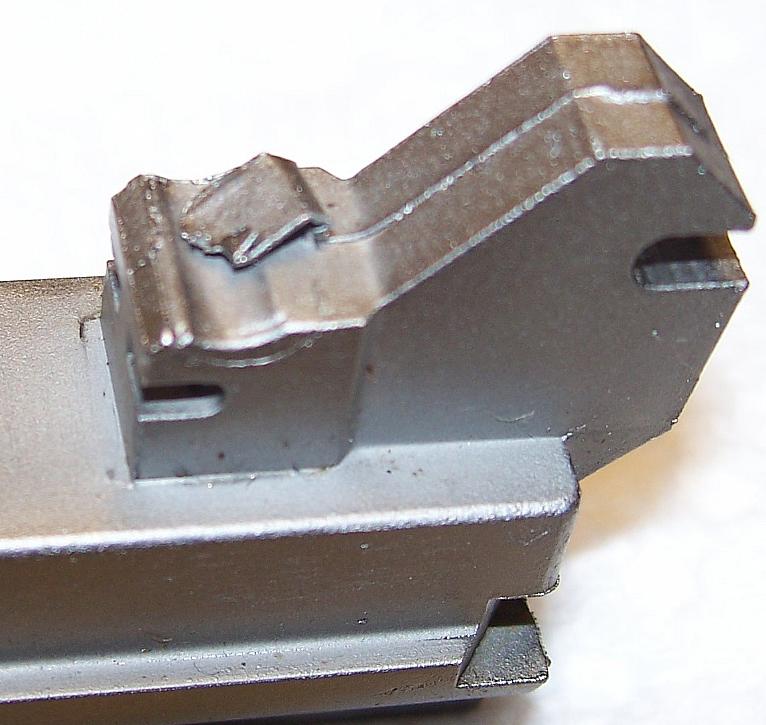
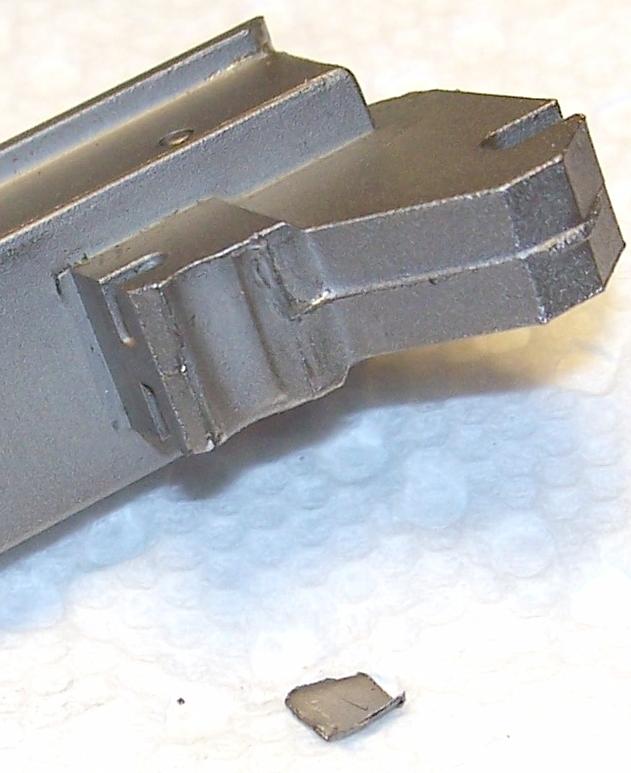
Here are some photos of the slide, and the slide return spring mechanism. The spring fits over a little stud on one end, and the other end of the spring butts up against a flat part at the front of the barrel. The bottom of the spring rests in a groove in the slide. The spring is uncapture, and sort of flimsy, and it will bend and kink easily when you try to re-install the slide on the frame.



The finish is rough, and the feed ramps are rough, too. I tried to polish the feed ramps on both barrels with a litte bit of fine grained sandpaper, and I was able to improve them a little bit. However, they are still rough. Also, you can see that there actually IS rifling inside the bore, so that may assist in accuracy. Here are a couple of photos...
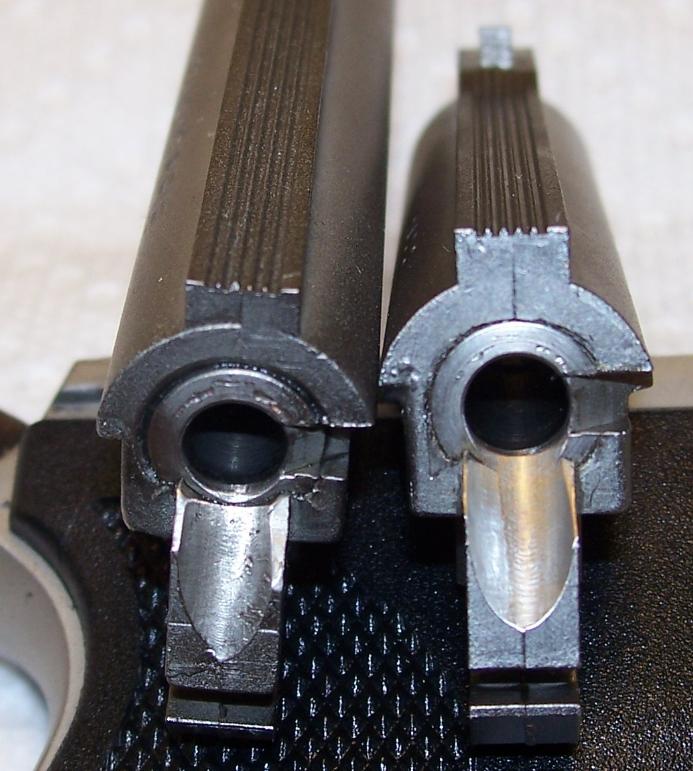
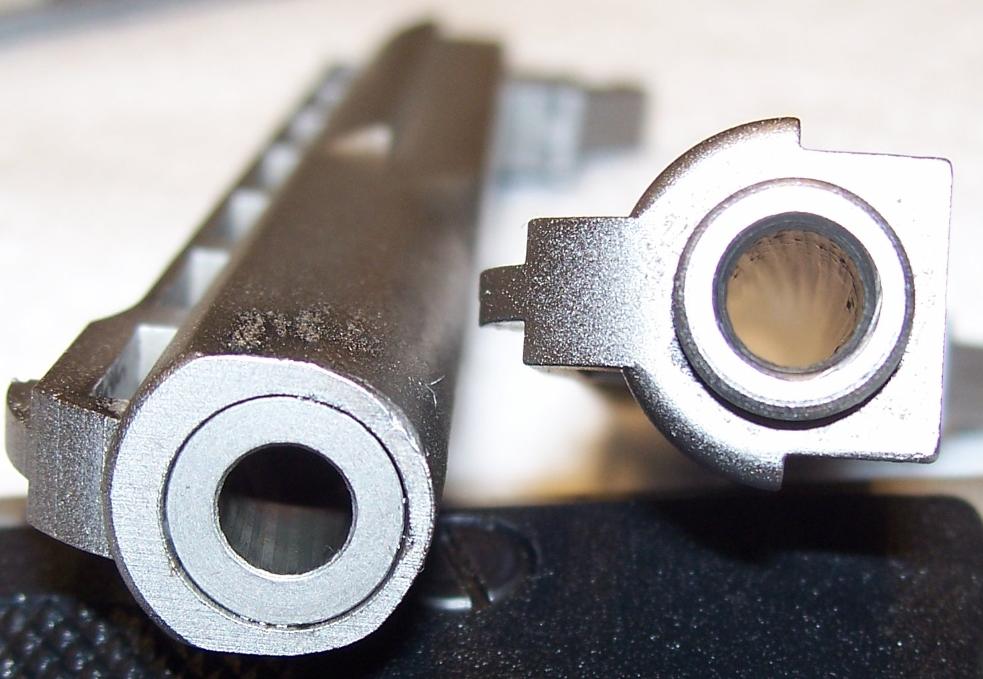
My pistol came with the longer barrel installed, and I was able to re-assemble the gun with THAT barrel. However, when I tried to re-assemble the gun with the shorter barrel, I was stymied. I couldn't do it. There is a slot on a lug beneath the barrel which is supposed to fit over a horizontal pin inside the frame, but I could not get that to fit, and the barrel to snap in place. It may be that the slot is slightly off, or too narrow, or it may be that there is something else preventing the shorter barrel from being inserted. I will have to work in this some more, because I would really like to see how the gun works with the shorter barrel. If it fires reliably, and if the short barrel will fit, it might be possible to pocket carry the gun.
UPDATE: I was wrong. The slot is OK, everything fits. I just didn't have the right technique for re-assembly. I found a video on YouTube that clarifies how to re-install the barrel, and I was able to install the short barrel without any difficulty. You just need to put the slide on first, and push it all the way back to where you can hold it there with the magazine safety button.
HOW TO CHANGE BARRELS: Make sure gun is unloaded and mag is in gun. pull the slide back and push the safety slide lock up to hold it back. Remove the barrel by pushing the take-down mechanism (little black flat levers on both sides of barrel) toward the front of the barrel. (For my gun, sometimes I can do it with my thumb nail. Other times I need to tap the locking lever with a screwdriver blade.)
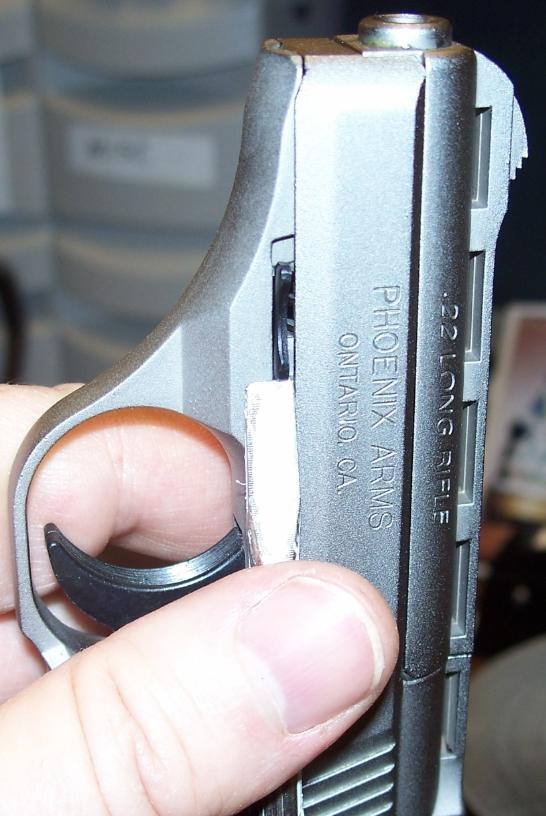
If you can't move the lever with your fingers, hold a screwdriver there,
then tap the handle of the screwdriver on your table or desk.
This will move the lever.
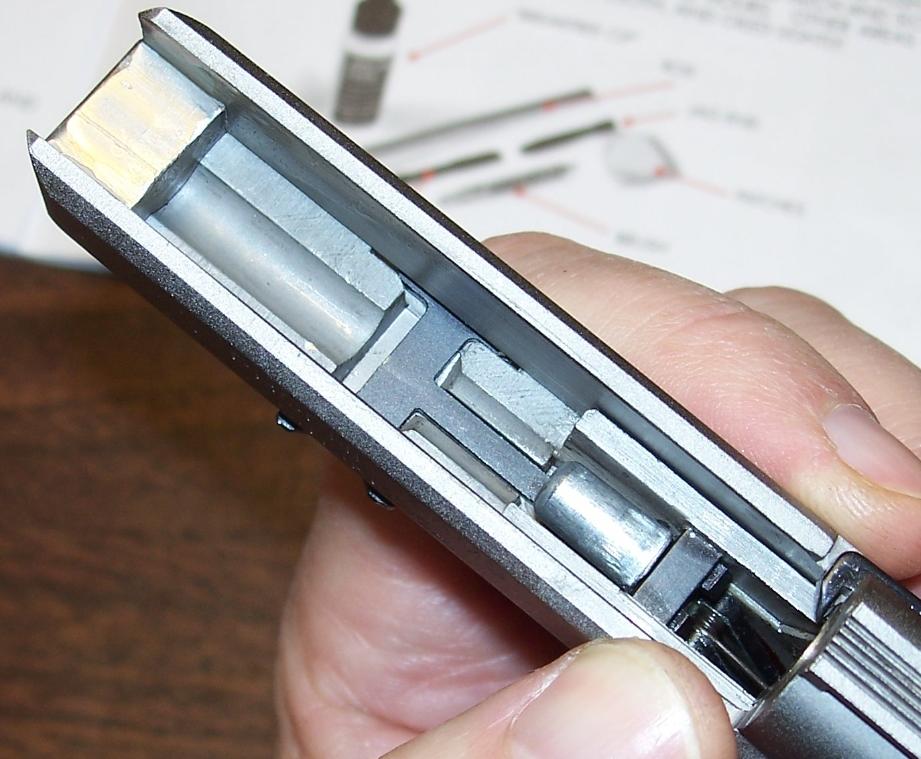
When the take-down-mechanism unlatches and moves forward, pull the barrel up and rotate it out of the frame. While you are doing this, WATCH OUT THAT THE SPRING immediately under the barrel, and sitting in the frame, does not fly out of the frame. Now you can remove the spring and latch mechanism for cleaning.
To reassemble with either short or long barrel, just do this:
1) Put the latch mechanism and spring back in the slide (not the frame), with the spring fitted over the little nub (which is part of the latch).
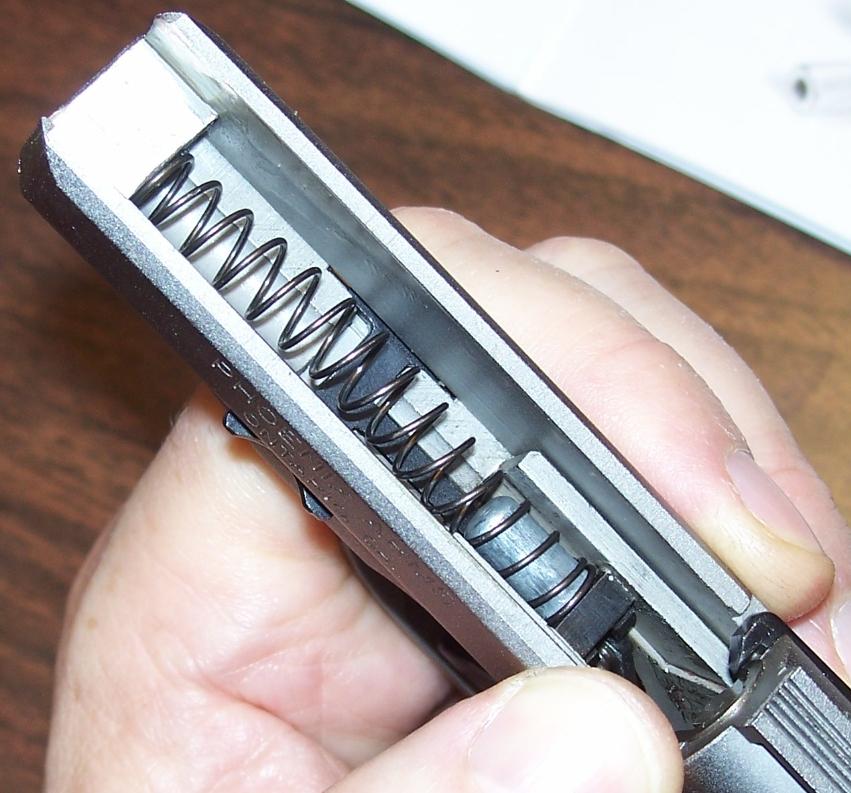
2) Slide the slide, with the spring in it, back as far as you can and use the safety lever to lock the slide in place. Be careful the spring stays in place while you do this. Hold it in tightly, so it won't kink or spring out. I use my thumb or fingers to hold the spring down.
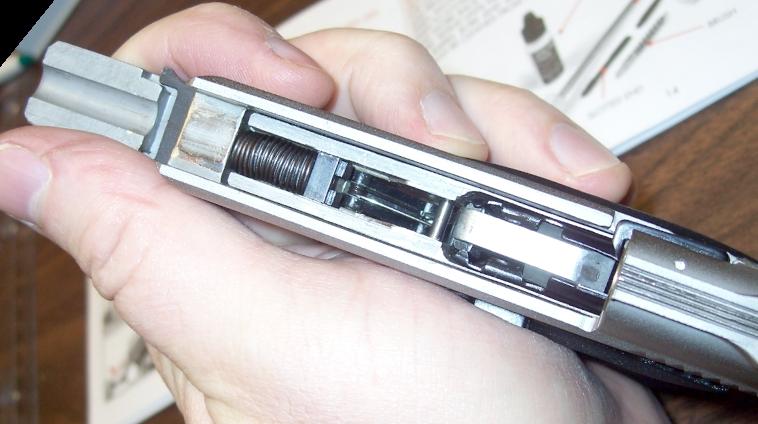
3) Insert either barrel into the frame so the slot in the cam at the rear of the barrel fits over the horizontal pin inside the frame, then rotate the barrel down until take down lever snaps forward and back and locks it into place.
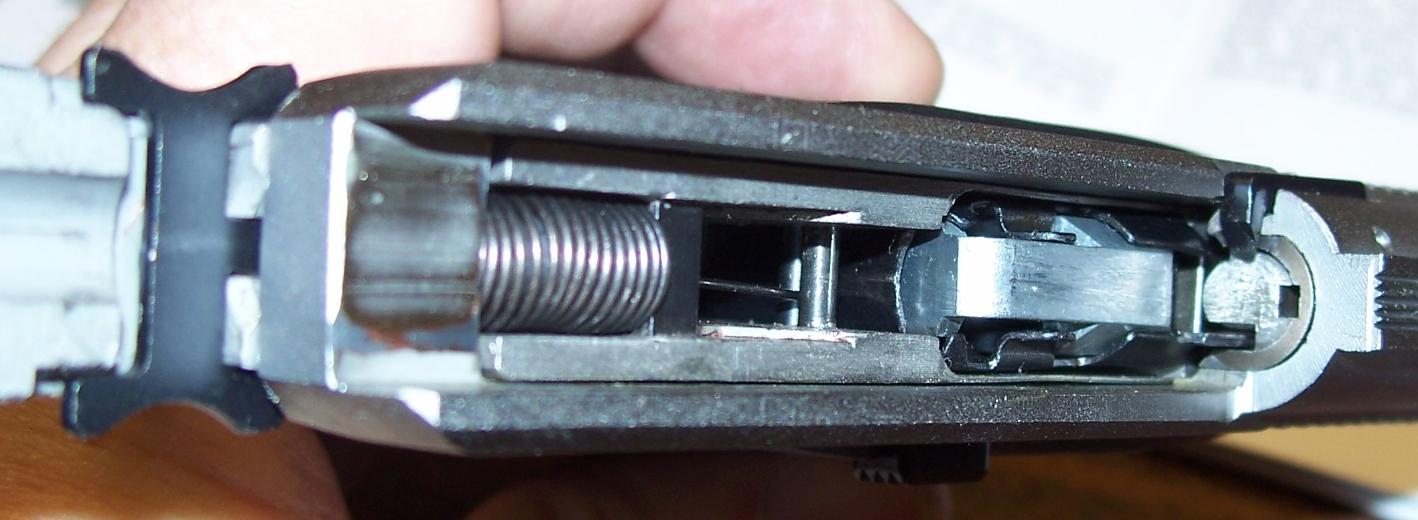
4) Release the safety so the slide will slam forward. Cycle the slide a few times now, to make sure all is well. Watch the video again, and this will all make perfect sense.
(I got good advice from "Wanderer32" and "Farmkid" on the Phoenix Forum concerning the above directions. Thanks, gentlemen!)
Here's a photo of my HP22A with the short barrel, and a Hogue Handall grip installed:
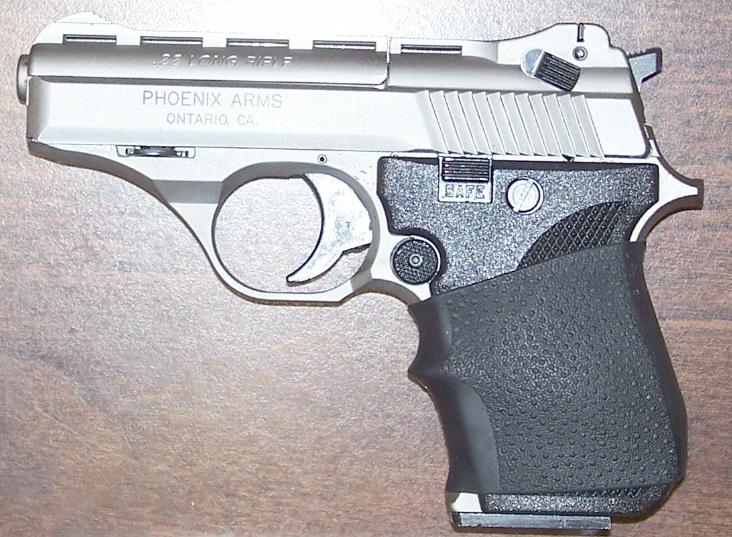
And here are the disassembled parts of the HP22A.


The serial number of the HP22A is stamped on the backstrap of the grip.

Some of you may find it interesting to compare the size of the HP22A to a Kel-Tec P11 (which I normally carry for self-defense). The HP22A is slightly smaller, but also about four ounces heavier, due to the heavy pot-metal construction. Here are two photos that give a good idea of the comparative sizes of the two firearms.

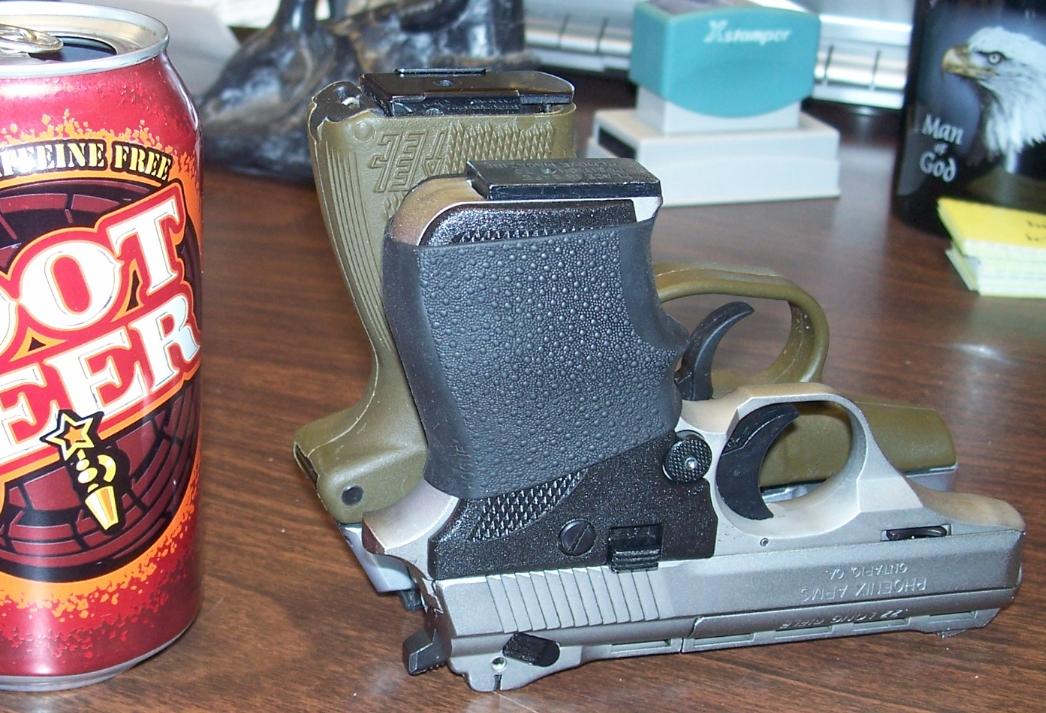
And here are two photos of my Kel-Tec P3AT with my HP22A. As you can see, the HP22A is a little bit larger. It is also quite a bit heavier than the P3AT, which makes the recoil very light indeed.


Range Report (November 7, 2009): November 7 was a Saturday, and it was bright, beautiful and about 60 degrees in SE Tennessee. Great! I had some time to test my HP22A, and called a friend who lives out in the County. Sometimes we shoot together in his "back yard." The HP22A functioned perfectly. No failures to eject, or fire. No jams. My ammo of choice were "mini-mags," which seem to work well in all .22 pistols. My targets were printed on 8.5x11 printer paper, and I was shooting one-handed at a range of 15 feet. I was not making any great effort for pinpoint accuracy, since I was just "out in the country," without a rest or chair, etc. I was chiefly concerned about function. Without really trying for accuracy, I was easily able to keep all my shots on the target, with fairly rapid fire. The trigger of the single-action HP22A is crisp and light. I will just say that I am completely satisfied with this little pistol! Here is a target shot up by "PapaChuck," which I found on GLOCKTALK.com.
